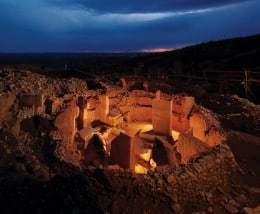 Today three pieces of news landed in my inbox that I wanted to comment on briefly. All three, though for different reasons, give conservative Christians something to think about.
Today three pieces of news landed in my inbox that I wanted to comment on briefly. All three, though for different reasons, give conservative Christians something to think about.
1) This is not new news, but “Biblical History Daily” (Biblical Archaeological Review) posted a brief article, “The Göbekli Tepe Ruins and the Origins of Neolithic Religion.” I first heard of this a few years ago, and digs have been going on there since 1994.
These ruins are of a 10,000 to 12,000 years old temple in modern day Turkey. The article asks whether this site, a sort of “Stonehenge,” is the oldest known religion in the world.
The article refers to it as “Turkey’s Stonehenge” because of the massive pillars that surround two large monoliths in the center. The pillars are fairly elaborately carved. The article states,
Given the early age of the site, equally surprising are the varied and often highly elaborate carvings that adorn the pillars of the Göbekli Tepe ruins. Among the pillars are detailed and often very realistic depictions of animal figures, including vultures and scorpions, lions, bulls, boars, foxes, gazelles, asses, snakes, and other birds and reptiles. In addition, some of the massive monoliths are carved with stylized anthropomorphic details—including arms, legs and clothing—that give the impression of large super-human beings watching over the enclosures.
the pillars of the Göbekli Tepe ruins. Among the pillars are detailed and often very realistic depictions of animal figures, including vultures and scorpions, lions, bulls, boars, foxes, gazelles, asses, snakes, and other birds and reptiles. In addition, some of the massive monoliths are carved with stylized anthropomorphic details—including arms, legs and clothing—that give the impression of large super-human beings watching over the enclosures.
We have here what seems to be evidence of a developed religious tradition 6000 to 8000 years before Abraham, the father of Israel, or 8000 to 10,000 years before Christ. You don’t need me to tell you that was a long time ago.
I just find that fascinating, and, if anything, a reminder that the biblical book of Genesis (which tells the story of father Abraham) giving us no more than a very small slice of one nation’s traditions. It also makes it a bit hard to read Genesis 1-12 (where Abraham makes his appearance) as a literal chronology of events, from creation to Abraham about 2000 years later.
2) An online article from NPR, “Dig Finds Evidence of Another Bethlehem,” tells us that the traditional site of Bethlehem (near Jerusalem) may not be the Bethlehem where Jesus was born. Another town called Bethlehem was found about 100 miles north, in the Galilee region.
 Archaeologist Aviram Oshri comments that this site was occupied by Jews at the time of Jesus and is only about 7 miles from Nazareth–which is where Mary and Joseph began their journey to Bethlehem in order to register, as the biblical story goes. A 7 mile donkey ride seems more reasonable than a 100 mile donkey ride, given Mary’s condition.
Archaeologist Aviram Oshri comments that this site was occupied by Jews at the time of Jesus and is only about 7 miles from Nazareth–which is where Mary and Joseph began their journey to Bethlehem in order to register, as the biblical story goes. A 7 mile donkey ride seems more reasonable than a 100 mile donkey ride, given Mary’s condition.
Though this may smack of borderline heresy for some, prominent New Testament scholar Paula Fredriksen reminds us that, “early Christianity only started to pay attention to the Judean Bethlehem in the fourth century, when the Emperor Constantine declared Christianity the official religion of the Roman Empire.”
A similar issue is well known in Old Testament scholarship: the location of Mt. Sinai. It was a longstanding tradition that Mt. Sinai was located in the southern Sinai peninsula (St. Catherine’s monastery), but it makes little sense for the Israelites to have wandered that far south. It is also unlikely that Moses would have driven his sheep so far south from Midian in Exodus 3.
I can imagine some people being very upset that tradition has been so unsettled–especially those who took Holy Land tours and have rolls of film of “Jesus’ birthplace.” Oh well. This isn’t the first time that tradition has given way to truth.
3) According to his website, much beleaguered Old Testament professor Christopher Rollston has resigned from his position at Emmanuel Christian Seminary over an issue that began with this article concerning woman in the ancient world. On his website, Rollston states that he has resigned “willingly” after reaching an “amicable resolution” with his former employer.
I am very sad to hear this, but this is just one of many such instances in recent years of trained and highly competent  scholars crossing the wrong people. Such public statements as Rollston makes are also common, and almost written in a code. To resign “willingly” more often than not means that the professor recognizes there is no way forward and that termination, with a drawn out and ugly public process beforehand, was inevitable, and he’d rather not spend the next few months (or years) waking up to it. “Amicable resolution” means the two parties agree not to perpetuate the conflict any further in public venues, which almost certainly involves a financial settlement.
scholars crossing the wrong people. Such public statements as Rollston makes are also common, and almost written in a code. To resign “willingly” more often than not means that the professor recognizes there is no way forward and that termination, with a drawn out and ugly public process beforehand, was inevitable, and he’d rather not spend the next few months (or years) waking up to it. “Amicable resolution” means the two parties agree not to perpetuate the conflict any further in public venues, which almost certainly involves a financial settlement.
Losing a job is difficult, but Rollston did the right thing. He needs to go where his gifts and training are valued rather than a problem to be solved. But conservative institutions are going to continue losing highly trained and talented good scholars over embarrassingly parochial issues. I sometimes feel it’s best for these schools simply to come clean and say, “We are not interested in academic integrity as much as maintaining the theological distinctives of of our tribe at the expense of academic integrity.” Maybe some school should stop offering academic degrees.
All three of these issues have very obvious solution, at least from an intellectual point of view, though that would require some theological flexibility on the part of some.
